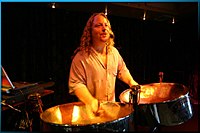Backing track
A backing track can be used by a one person band (e.g., a singer-guitarist) to add any amount of bass, drums and keyboards to their live shows without the cost of hiring extra musicians.Bands or solo musicians may use backing tracks to add extra instrumental or vocal tracks to a live performance, to enhance the sound (as in the employment of doubled backing vocals) or to replicate more closely the instrumentation heard on a recording (as in the use of additional recorded parts such as string sections which would be costly to reproduce live.)Music backing tracks are also available for instrumental practice and jamming by jazz musicians, to help beginning to intermediate performers play to a song's rhythm part or learn to improvise over chord progressions.[citation needed] Some musicians have spoken out against the use of backing tracks; notably, Elton John said in 2004 that "anyone who lip-syncs in public onstage when you pay 75 pounds to see them should be shot."(Specifically, he levied this criticism at Madonna, who does use backing tracks on tour, although accusations of lip synching were denied by her management, who argued it is not the same as miming.
Instrumentalsteel drumaudio recordingdigital recordingsynthesized instrumentsrhythm sectionaccompanimentstring sectionone person bandpower triohorn sectionbacking vocalsstring sectionsbackup bandkaraokechord progressionssession musiciansinstrumentselectronic musicprogrammedmiming the playing of their instrumentslip-synchingreality TVsound engineersbacking bandsaudio tapeboom-boxDigital sequencerssynthesizersSparksdigital audio workstationMiniDiscMP3 playersound modulesElton JohnMadonnamimingPet Shop BoysRoger WatersOffstage musicians and singers in popular musicYouTube